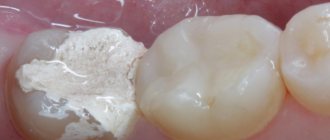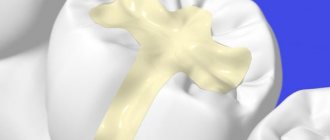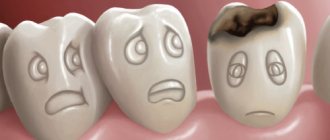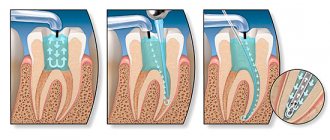Absolutely every person has heard that caries needs to be treated on time. But despite the warnings of dentists, there is a large amount of information on the Internet on the complications of advanced caries - people come to the clinic when the caries has become deep or has turned into pulpitis or periodontitis.
How deep caries will be treated - we will tell you about this below and will definitely tell you in the article:
- About what deep caries is;
- Consider the symptoms of deep caries;
- Let's look at the stages of treatment for deep caries;
- We’ll tell you whether it’s painful to treat deep caries;
- We will indicate the prices for the service in Moscow
Calculate the cost of treatment by taking a short test in 20 seconds!
Do not delay your treatment, because in this matter time plays against us.
Deep caries: what is it and how does this stage of the disease manifest itself?
Caries is a disease that goes through several successive stages in its development. A carious tooth lesion begins with a small spot on the enamel and, if measures are not taken and you do not contact a specialist, the destructive process will progress, affect the internal tissues of the tooth, and eventually the disease will reach the stage of deep caries.
When caries is advanced, a deep carious cavity forms in the tooth, reaching almost to the pulp (nerve of the tooth). Between the pulp and destroyed dental tissues there remains a thin layer of healthy dentin, which is not sufficient protection of the tooth nerve from infection. If deep caries is not treated urgently, it will turn into pulpitis or periodontitis - complications that can lead to tooth loss.
Deep caries is clearly visible visually (if not hidden by a poorly installed filling) and has clear symptoms:
- With deep caries, the tooth hurts. Painful sensations occur when a tooth with caries comes into contact with external irritants - hot/cold, sour/sweet foods;
- You can see a deep, dark-colored cavity in the tooth (as people say, there is a big hole in the tooth);
- Since the carious cavity with deep caries becomes clogged with food debris, a strong and unpleasant odor may appear from the mouth.
WORTH LEARNING AND REMEMBERING: How do you understand that a tooth hurts because of deep caries, and not because of pulpitis? Pain during deep caries can be quite severe, but it quickly disappears if the external irritant that provoked the pain syndrome is eliminated. With pulpitis, the tooth hurts for a long time and in attacks. In any case, pain in a tooth is already a reason to visit a dentist. Remember that the longer you delay dental treatment, the higher the risk of losing a tooth!
Reasons for the development of pathology
Deep carious lesions most often appear due to lack of treatment of caries in the initial stages. The second main reason is the invisible destruction of dental tissue under a filling or crown. If a person does not visit the dentist for regular oral examinations, he may unexpectedly encounter an unpleasant problem.
Primary damage to the enamel, and subsequently deep caries occurs due to:
- insufficient oral hygiene;
- genetic predisposition;
- congenital enamel defects;
- dysbacteriosis in the oral cavity;
- disturbances of mineral metabolism (lack of fluoride, calcium);
- abundance of carbohydrates in food.
It all starts with plaque due to the activity of bacteria that produce acids that destroy enamel - the natural protection of teeth. The weaker and thinner this layer, as, for example, in baby teeth, the more likely the development of pathology and the formation of deep carious areas. It is thin in children, people with mineral deficiencies (poor nutrition, chronic diseases) or congenital defects in the structure of the teeth. If you care for your oral cavity irregularly or incorrectly, then even with good health of the dental system, pathogenic microorganisms can break through and lead to caries.
Diagnosis of deep caries
Treatment of deep caries begins with diagnosis, which includes the following measures:
- Visual inspection;
- X-ray of the tooth.
Why do you need a dental x-ray before treating deep caries? A photograph of the tooth must be taken in order to:
1. To identify deep caries under a filling. If the tooth was treated poorly in the past, during its treatment the doctor did not remove all the tissue damaged by caries - the tooth will continue to decay under the filling. In this case, caries may well develop into a deep form, that is, it can reach almost to the nerve of the tooth.
2. To see the degree of development of the inflammatory process and understand whether deep caries has had time to develop into pulpitis, the treatment of which follows a slightly different scheme.
Probing of the tooth to assess the degree of softening of internal tissues in deep caries is not carried out. Since the destruction has reached almost to the nerve, this diagnostic procedure can cause severe pain to the patient.
How to treat deep caries: an overview of the main stages of the treatment process
After the diagnosis of “deep caries” is made, a decision is made on how treatment will be carried out - in one or two stages. The correct approach to quality treatment of deep caries will involve two stages, not one. Why? Let's explain in detail.
Through the thin layer of dentin, which is preserved in the tooth when caries develops to a deep form, carious bacteria can easily penetrate into the pulp. The initial stage of pulp infection may not be visible on the image, but it is extremely important to exclude it so that the tooth does not begin to hurt under the filling.
Therefore, at the first stage of treatment of deep caries, all destroyed tissue is removed, a cavity is formed for a filling, into which the medicine is placed, and the tooth is closed with a temporary filling. In the treatment of deep caries, a break is taken for 2-3 days: if during this time the tooth does not begin to hurt, then at the next visit to the doctor’s office, a permanent filling will be placed on it.
Below we provide a detailed treatment plan for deep caries:
1. Treatment of deep caries begins with mandatory anesthesia of the manipulation area. Local anesthetics are used for this purpose.
WORTH LEARNING AND REMEMBERING: Is it painful to treat deep caries? People often ask this question on the Internet, in various forums. You can answer it this way: modern anesthetics used in the treatment of deep caries make it possible to carry out all the necessary medical procedures without pain and discomfort for the patient. Therefore, do not be afraid to treat your teeth because of vain and unfounded fears that dental treatment is painful.
2. The treatment area is isolated with a rubber dam - a special latex scarf. Isolation of teeth during treatment is important: it protects the treated tooth from contact with oral microflora, which may contain harmful bacteria. In addition, the latex lining prevents moisture from entering the already formed cavity for installation of the filling. Moisture during filling installation affects the strength, reliability and durability of the restoration.
3. After the anesthetic takes effect, the dentist will begin working with the tooth - you need to remove all tissue damaged and destroyed by caries, and also form a cavity for installing a filling. Removal of destroyed tooth tissue is done using a drill.
4. A special therapeutic lining based on calcium is placed into the prepared tooth cavity. This gasket will help destroy pathogenic microflora and prevent the risks of developing pulpitis.development of pulpitis. After the treatment pad, an insulating pad is installed in the tooth, which helps secure the treatment pad and isolates it from the filling - temporary or permanent.
Next, a temporary filling is placed on the tooth and the next time the person should come to the clinic in a couple of days. During the second visit, the dentist will ask the patient about possible pain in the tooth, conduct an examination, and if there are no complaints of pain or signs of inflammation, a permanent filling will be placed on the tooth. At this point, the process of treating deep caries can be considered complete.
WORTH LEARNING AND REMEMBERING: If a tooth is destroyed by deep caries, then restoring it with a filling is impractical. Large fillings simply do not hold strong enough and can fall out or break, damaging the root of the tooth. Therefore, teeth with tissue destruction of more than 50% are restored with inlays or filling, and then covered with a crown.
Pros and cons of using medicinal pads in dentistry
The use of medicinal pads in dental practice has a number of advantages:
- They relieve inflammation, promote tissue regeneration, and help prepare the tooth for filling.
- Many drugs contain anesthetics that provide an analgesic effect, which is important when treating tissues near the sensitive dental nerve.
- Most materials are highly plastic, harden quickly and prevent the formation of microscopic cracks in the tooth.
In addition to the advantages, therapeutic pads have a number of disadvantages:
- They impair the adhesion of the filling to the walls and bottom of the cavity, which can shorten the service life of the restored tooth.
- If the technology for installing a medical pad is violated, the risk of tissue infection increases.
- Most materials dissolve when exposed to liquids, so they must be replaced frequently.
Despite the disadvantages, medicinal pads are still widely used in dentistry, as they have a wide spectrum of action and help solve many therapeutic problems.
Is it possible to treat deep caries in one stage?
A one-stage approach to the treatment of deep caries is extremely undesirable, since it does not eliminate 100% the risks of developing pulpitis under an already installed permanent filling. But sometimes deep caries is treated in one stage. To decide whether such a decision is appropriate, the dentist must evaluate a number of factors:
- The thickness of the remaining healthy dentin;
- The severity and nature of pain in the tooth that the patient complains of.
When working with a tooth affected by deep caries, it is not always possible to remove damaged tissue without affecting the pulp chamber. If this happens, treatment of deep caries cannot be carried out in one stage!
Consequences of advanced disease
Studies have shown that patients with complicated and advanced caries have an increased risk of developing cardiovascular and inflammatory diseases. The fact is that bacteria that settle in a person’s mouth have a detrimental effect on the teeth and infect the connective tissue. As you know, internal organs consist of 60-90% connective tissue. Therefore, when a person has a lot of damaged teeth, he is diagnosed with the following chronic diseases:
- Tonsillitis, bronchitis;
- Rheumatism;
- Osteomyelitis;
- Leukoplakia is an inflammation of the mucous membrane in the mouth, including the tongue.
Complications of deep caries
If the treatment of deep caries is not carried out in a timely manner or it is of poor quality, complications may develop, the treatment of which will be more complex and more expensive. Complications of deep caries include pulpitis and periodontitis - inflammatory processes that affect the nerve and root of the tooth and may well lead to the need for tooth extraction.
Pulpitis and periodontitis are treated according to a different scheme, which involves removing the nerve of the tooth and treating the dental canals. Naturally, the cost of treating complications will be higher than the cost of treating deep caries.
Types and classification
Forks of deep caries according to the location of the defect:
- Fissure. The lesion affects the grooves and natural grooves on the chewing surfaces of the teeth and spreads deeper.
- Approximal (contact). The area on the side of the tooth that is in contact with the adjacent unit is destroyed.
- Cervical. Caries develops near the gums, near the root collar.
Deep caries can have two forms - acute and chronic. They are characterized by different widths of the inlet and the base of the cavity.
Is it possible to cure deep caries with folk remedies or at home?
Some people are so afraid of dentists that even when a tooth starts to hurt badly, they do not go to the clinic, but start looking for traditional medicine recipes against caries or take antibiotics, hoping that these drugs will get rid of caries.
Let us write right away that such amateur activity is useless and dangerous. Caries cannot be cured at home either with decoctions or tablets from the pharmacy. To stop the process of tooth decay, you need to remove damaged tissue and destroy bacteria. And all these procedures are feasible only in a clinical setting.
If the tooth continues to hurt
Mild pain immediately after treatment of deep caries is not a cause for concern. They are recognized by dentists as the norm and do not require special treatment. Mild pain in the tooth after treatment of deep caries can be explained by the fact that the gums were affected during the treatment procedures. After 1-2 days, the discomfort will go away on its own.
But if, after treatment of deep caries, the tooth hurts severely and for a long time (more than 2-3 days) and, against the background of the pain syndrome, a high temperature and swelling of the gums appear - all this may indicate a poor quality of treatment and the development of an inflammatory process under the filling. With such symptoms, you cannot do nothing: you need to urgently contact the dentist.
To eliminate the risk that your tooth will hurt after treatment, you need to carefully choose the clinic where you will have your teeth treated. You should not choose dentistry based on the most beautiful advertising that promises the lowest prices - you should find out all the details about the level of equipment of the clinic, the technologies that are used in it, the level of qualifications, and the doctors working in it.
All conditions for high-quality treatment of deep dental caries have been created in our clinic in Moscow - VENSTOM.
Calculate the cost of treatment by taking a short test in 20 seconds!
Do not delay your treatment, because in this matter time plays against us.
Cost of the service in Moscow
Of course, the cost of treating deep caries will be higher than the cost of treating initial caries, because the treatment process will be more complex, including various manipulations and carried out in two stages.
On average, the cost of treating deep caries of one tooth can amount to 5-6 thousand rubles, and this is if there is no need for treatment of the tooth canals. If you want to find out for yourself the exact cost of caries treatment in your case, you definitely need to visit the dentist’s office. The doctor will examine the clinical picture, conduct a diagnosis and, before starting treatment, announce its full cost.











